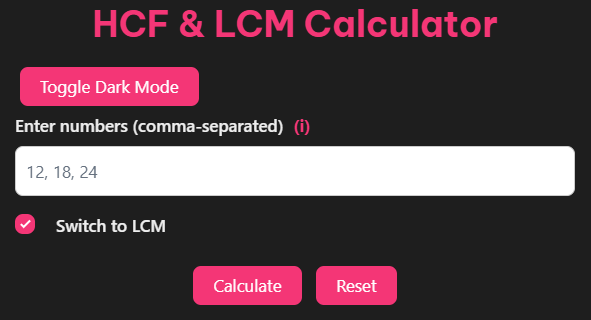HCF & LCM Calculator
HCF: -
Steps:
Whether you’re a student learning about number theory, an educator teaching mathematical concepts, or a professional working with numerical analysis, finding the Highest Common Factor (HCF) can be a time-consuming process. Our free HCF calculator 2025 offers a fast, accurate solution that not only provides instant results but also shows you the step-by-step process for better understanding.
What is HCF?
The Highest Common Factor (HCF), also known as the Greatest Common Factor (GCF) or Greatest Common Divisor (GCD), is the largest positive integer that divides all given numbers evenly without leaving any remainder. Think of it as the biggest number that all your input numbers have in common as a factor.
For example, let’s look at the numbers 18, 30, and 42. The factors of 18 are 1, 2, 3, 6, 9, and 18. The factors of 30 are 1, 2, 3, 5, 6, 10, 15, and 30. The factors of 42 are 1, 2, 3, 6, 7, 14, 21, and 42. The common factors are 1, 2, 3, and 6, making 6 the HCF of these three numbers.
Methods to Calculate HCF
Understanding different calculation methods helps you choose the most efficient approach for your specific problem. Let’s explore the three main methods:
Prime Factorization Method
This method involves breaking down each number into its prime factors and identifying the common ones.
Example 1: Find the GCF of 12 and 18 using prime factorization.
- 12 = 2 × 2 × 3
- 18 = 2 × 3 × 3
- Common factors: 2 and 3
- GCF(12, 18) = 2 × 3 = 6
Division Method (Euclidean Algorithm)
This systematic approach uses division to find the HCF efficiently.
Example 2: Find the GCF of 24 and 36 using the Euclidean Algorithm.
- 36 ÷ 24 = 1 remainder 12
- 24 ÷ 12 = 2 remainder 0
- The last divisor is 12, so HCF(24, 36) = 12
Listing Factors Method
This straightforward approach involves listing all factors and finding the greatest common one.
Example 3: Determine the GCF of 20, 50, and 120.
- Factors of 20: 1, 2, 4, 5, 10, 20
- Factors of 50: 1, 2, 5, 10, 25, 50
- Factors of 120: 1, 2, 3, 4, 5, 6, 8, 10, 12, 15, 20, 24, 30, 40, 60, 120
- Greatest common factor: 10
Step-by-Step Guide to Using Our Online HCF Calculator

Our user-friendly HCF calculator makes complex calculations simple:
- Enter your numbers: Type your comma-separated values in the input box (for example: 24, 36, 48)
- Click Calculate: Press the calculate button to process your numbers
- View results: See both the HCF and LCM results instantly
- Study the steps: Review the detailed calculation process for each method
The calculator automatically shows you the manual calculation process, helping you understand how the result was obtained. This feature makes it perfect for learning and verification purposes.
Benefits of Using Our Online HCF Calculator
Convenience and Speed
Manual HCF calculations can take several minutes, especially with larger numbers or multiple values. Our calculator delivers results in seconds, saving valuable time for students during exams and professionals during work.
Accuracy and Reliability
Human errors in mathematical calculations are common, particularly when dealing with complex numbers. Our calculator eliminates these mistakes, providing consistently accurate results every time.
Educational Value
Unlike simple calculators that only show answers, our tool displays step-by-step solutions using different methods. This helps students understand the underlying concepts and improves their mathematical skills.
Multiple Calculation Methods
Our calculator supports prime factorization, the Euclidean Algorithm, and factor listing methods, giving you flexibility in how you approach the problem.
Real-Life Applications of HCF
Understanding HCF has practical importance beyond mathematics textbooks:
Resource Division and Planning
Example 4: A retail manager needs to optimize inventory cycles. If Product A sells 20 units per cycle, Product B sells 50 units, and Product C sells 120 units, finding the HCF helps determine the most efficient restocking schedule. The HCF of 20, 50, and 120 is 10, suggesting inventory checks every 10 units.
Fraction Simplification
Example 5: When working with fractions like 24/36, finding the HCF (which is 12) allows you to simplify it to 2/3, making calculations easier and results clearer.
Fair Distribution
Example 6: If you need to divide 24 apples, 36 oranges, and 48 bananas equally among groups, the HCF tells you the maximum number of equal groups possible. With HCF(24, 36, 48) = 12, you can create 12 equal groups.
Features of Our Free Online HCF & LCM Calculator
Our calculator stands out from competitors with several unique advantages:
- Instant dual results: Get both HCF and LCM calculations simultaneously
- Step-by-step solutions: See detailed workings for prime factorization and Euclidean methods
- Multiple method support: Choose from different calculation approaches
- Common factor highlighting: Easily identify shared factors across numbers
- User-friendly interface: Clean, intuitive design for effortless calculations
- Educational focus: Perfect for students, educators, and professionals
- Free access: No registration or payment required
- Mobile compatibility: Works seamlessly on all devices
Get Started with Instant HCF Calculations
Don’t let complex HCF calculations slow you down. Whether you’re working on homework, preparing for exams, or solving real-world problems, our free HCF calculator 2025 provides the speed, accuracy, and educational value you need.
Try Our Free HCF Calculator today and experience the difference that instant, accurate calculations can make in your mathematical work. With step-by-step solutions and support for multiple calculation methods, you’ll not only get the right answer but also deepen your understanding of these fundamental mathematical concepts.